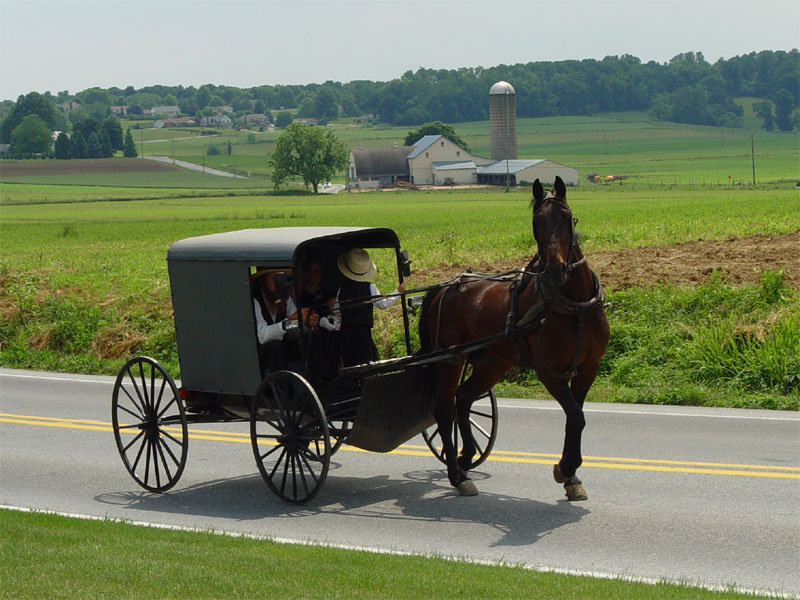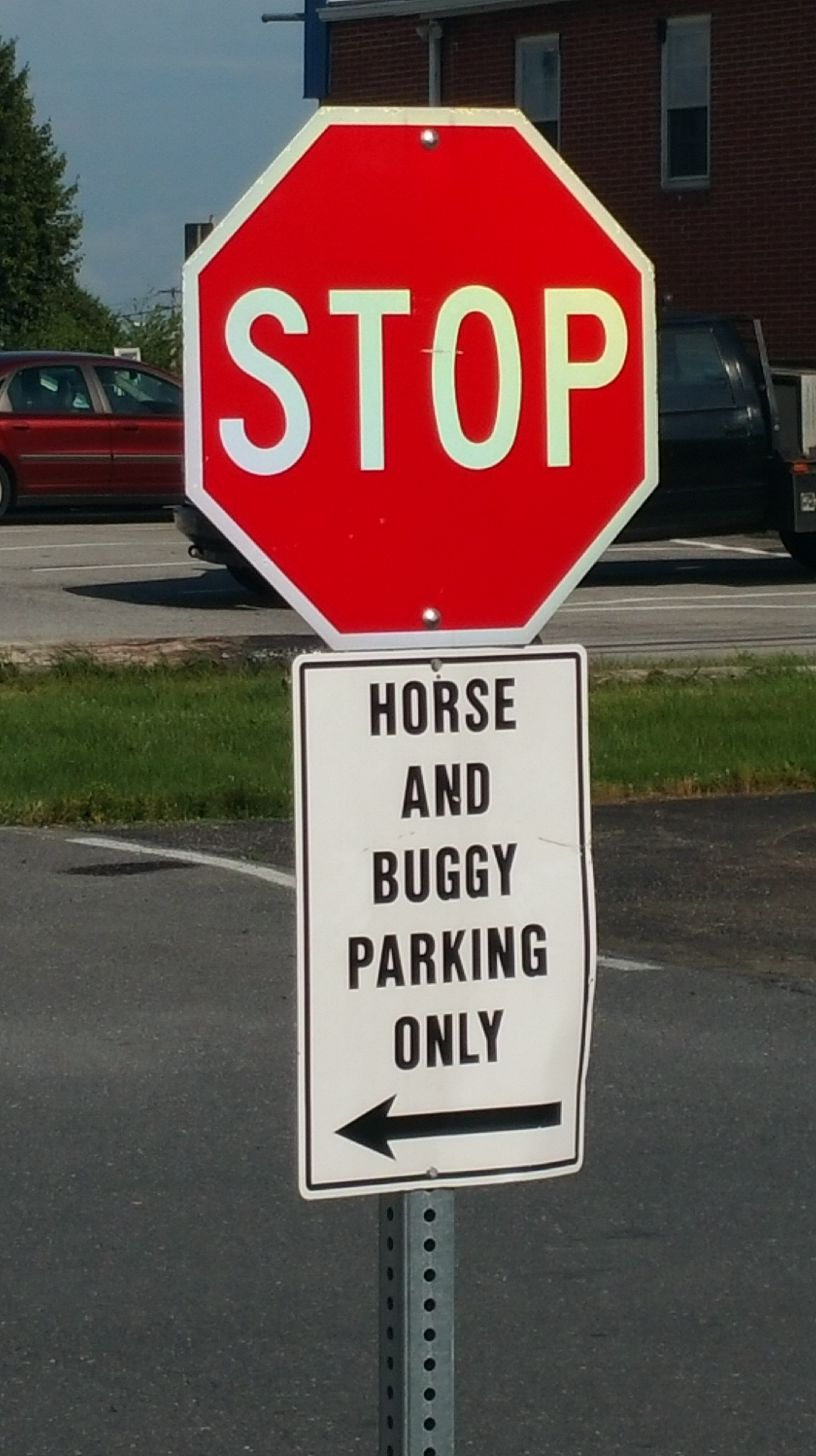
Driving down the roads of Lancaster County PA there is a dark covered buggy pulled by a single horse, a bearded man staring ahead is holding the reins, and a mother with her children in the tiny compartment behind. It could be a scene from the seventeen or eighteen hundreds, but this is modern day America, with cars, trucks, semis also competing for the same road. We are in Amish country–as we see another, and yet another buggy making their way down the busy roads.
At a time when the emphasis in modern culture is on the latest upgrade, Amish have chosen the opposite way. Striving for humility drives their decision making process. Far from wanting to stand out from the crowd, Amish want to blend into their community. They have embraced a few changes since their coming to America: use of propane, diesel engine/generators, tractors to use the power-take-off capacity to operate processing equipment (not for use in the fields), and occasionally cell phones for business (never in the home). These innovations are often in response to the demands of the world around them, and I am sure each have been considered from every possible side before being adopted by the local district. Some use of modernity has been in response to the law of the land. For instance power is needed for milking machines which are required, so a electric generator is used, but power is never taken from the grid. A carefully considered interaction with English (anyone not Amish is referred to as English) means a truck can deliver goods to an Amish home loaded with lumber or propane, but an Amish would not own or operate such a truck. An Amish may work as a carpenter for an English, but it is preferable to work at home, on the farm or in a cottage industry.
Far from diminishing in numbers, today over 90% of young Amish choose this traditional life. Amish are part of the Anabaptist movement, baptism only occurs when an individual can make it a conscious choice. Between the ages of 16 and twenty-something, during which time they can freely mix with the outside culture so that they may make an informed choice, a young woman or man can then choose to be baptized. Baptism is entering the community as an adult and can marry, only another Amish. If one chooses not to be baptized, then they may continue to have contact with the family and community. Many of those who do not continue as Amish become Mennonites, who have similar beliefs but are more liberal in dress and lifestyle. In the past 20 years the Amish population has doubled, from 100,000 to over 250,000 Nationwide. The estimate is that in another twenty years the Amish population will double its number again, currently about 31,000 in Lancaster County; it is not unusual for a family to have seven or more children. If an adult chooses baptism, but then later leaves the community, they risk being shunned, no communication or support, with the idea that the wayward soul will come back–baptism and marriage are considered to be commitments for life; although remarriage is encouraged if there is a death of a spouse.
Three key teachings of the Amish concern: the rejection of pride or arrogance (Hockmut), cultivation of humility (Demut), and calmness (Gelassenheit). To promote these values they dress simply, a single color (no plaids), black, gray and purple are common colors. The men wear beards but no mustache–mustaches were once a source of pride for men. Modern day conveniences, such as electricity, cars, trucks, or cameras are eschewed due to the probability of competition and pride, or taking time and focus away from the family and community (no Air Jordan’s or $150 jeans for the kids). You have to carefully consider going to the store if you are being pulled by a horse, versus jumping into your car. The idea is to be more grounded in the earth through farming or a cottage craft.
The Amish originated in Switzerland (German speaking Swiss) in 1683 by Jakob Ammann (The name Amish is a derivative of Ammann). Due to persecution in Switzerland and Germany they moved to Pennsylvania, where William Penn, a Quaker, practiced tolerance for all religions. It is theorized that when asked where they were from, they responded Deutschland (Germany), and it was thought they were saying Dutchland; so went the association that they were from Holland (not true) and it has stuck (much like first nations in North America are stuck with being Indians, even though it has been well known from early on they are not from India). At home and amongst themselves Amish speak a dialect of German. Over time that dialect has changed to such a degree that a native German cannot understand an Amish. English is learned when children go to school.
All Amish we have met, mostly men and women vendors selling goods, have been friendly, not standoffish, they speak very good accented english, and are overall a very handsome group of people. Parking lots regularly have signs for hitching posts for horses, even at Costco. They have large family gardens, but also buy goods from local stores. They are not particularly focused on modern day health food standards: they use pesticides on crops, grow tobacco for a cash crop, and a favorite recipe is Amish Peanut Butter: peanut butter and marshmallow combined! Only a third are now full time farmers, others have branched out to cottage industries–too many for farming to support. Amish are famous for making furniture, also various crafts of high quality. Schooling, in their own one room school, which ends at grade eight, and no further. Then for boys, it is on to unpaid apprenticeships.
Church is every other week, held at a family location. There are districts within the community, an average district will be about 80 adults plus children. Service begins at 8:30 with a short talk, slow singing (an average song lasts about 15 minutes), followed by silence, then a longer talk. After Service there is food, which is an important part of any Amish gathering. Community norms are enforced: no drinking, no drugs, no smoking. They will use modern hospitals, but do not have health insurance and they do not collect social security, older adults live at home with the family. They pay taxes, but do not use the schools or other government services. They are pacifists, so no military service. If someone is in trouble, if a house or barn burns down the community bands together to meet the emergency and skilled labor shows up to rebuild.
A tragic and touching story came about in 2006 that tells much of how Amish live their values. A deranged man came into an Amish schoolhouse and shot ten girls, killing five and seriously wounding the others; then he killed himself. The Amish put into practice forgiveness when they respectfully came to the killer’s funeral after attending the funerals of their own girls. Not long afterward, the Amish community gave money to the killer’s family, his wife and three children who were now without a husband and father. One can only imagine the shock and horror of a close community when a local man kills their children, and what it would take to then be mindful enough to think of the needs of a sudden widow and her children of the murderer. It is quite a thing to do.
As we travel in the county today we are mindful that the Amish do not care to have their photographs taken; no graven images of God (little figurines of Amish by a local artist have blank faces)–it may also turn into a source of pride. I am sure that every compromise with the society they live in is very carefully debated–each district to some degree sets their own rules; so you do see variations. Carla mentioned during our time here, it has felt peaceful. And it is true. After a week of being here, longer than we had initially thought to stay, and contending with all the usual traffic, seeing the box stores and outlet malls, there is even a “Dutch” amusement park nearby, but underneath it all there is a quiet vibration that makes this a special place.
A young Amish man is drawn to our campground by a single horse. His buggy with his wife and children tucked in behind has has a small trailer he is towing. He is sweet natured, selling canned “chow chow,” delicious pickled mixed vegetables, fresh lemonade, he has a whole miniature store in his wagon. He stops and very quickly a crowd is around him buying his goods. What root beer he sells in quart jars, fabulous. Pickled beets, the best I have ever had. We see him a couple of times over the days we are here. He is soft spoken, his wife demure in the back, one of the kids, a small boy, has his bare foot up over the top of the tailgate of the buggy, and while the word quaint naturally comes to mind, they are not trying to be quaint–they are simply living their faith.
It does provide an interesting counterpoint to our constant movement on this pilgrimage of ours, our vehicles, our use of electronic gadgetry as I am writing these words on an electronic tablet that I will send out on the world wide web. And while I do not choose their lifestyle (the closest I would have come is when I was in silence and seclusion for a year), nevertheless I find there is an appeal to living so close to the earth, and the absence of our many modern conveniences, that often come with hidden costs that can derail us from simplicity. One takeaway is that we can choose simplicity in our daily life. Perhaps walk to someplace close by, or ride a bike (Amish do not ride bikes, but foot powered scooters), take time away from electronics–find ways to be a little Amish, to be simpler in day-to-day living.
